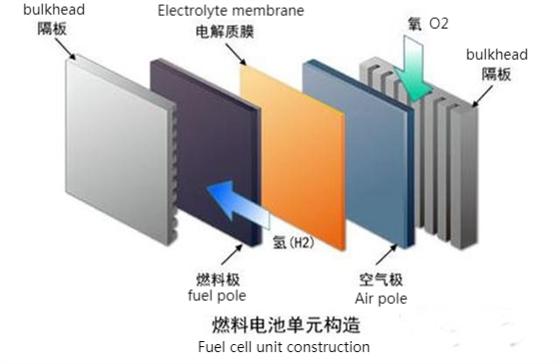- English
- Español
- Português
- русский
- Français
- 日本語
- Deutsch
- tiếng Việt
- Italiano
- Nederlands
- ภาษาไทย
- Polski
- 한국어
- Svenska
- magyar
- Malay
- বাংলা ভাষার
- Dansk
- Suomi
- हिन्दी
- Pilipino
- Türkçe
- Gaeilge
- العربية
- Indonesia
- Norsk
- تمل
- český
- ελληνικά
- український
- Javanese
- فارسی
- தமிழ்
- తెలుగు
- नेपाली
- Burmese
- български
- ລາວ
- Latine
- Қазақша
- Euskal
- Azərbaycan
- Slovenský jazyk
- Македонски
- Lietuvos
- Eesti Keel
- Română
- Slovenski
- मराठी
- Srpski језик
Detailed explanation of fuel cell structure
2022-08-02
The fuel cell stack is composed of multiple fuel cell monomers stacked in series. Bipolar plate and membrane electrode MEA overlapping alternately, each monomer embedded between the seal, after the front and back end plate pressing with screw fastening fastening, that is, fuel cell stack. Fuel cell stack is the place where electrochemical reaction takes place, which is the core part of fuel cell system (or fuel cell engine). When the reactor is working, hydrogen and oxygen are distributed to the bipolar plates of each single cell through the main gas channel of the reactor, and then evenly distributed to the electrodes through the bipolar plate guide. Electrochemical reactions are carried out by contacting the electrode support body with the catalyst.

1. Fuel cell single cell:
A fuel cell cell cell consists of a seven-layer structure, with the middle layer being a proton exchange film (also known as an electrolyte film), followed symmetrically by a negative/anodic catalytic layer, a negative/anodic gas diffusion layer, and a negative/anode bipolar plate.
2. Stack structure of electric stack:
For fuel cells, a single cell consisting of a set of electrodes and electrolyte plates has low output voltage and low current density. In order to obtain high voltage and power, several single cells are usually connected in series to form an electric stack. The adjacent single battery is separated by a bipolar plate, which is used to connect the front and rear single battery and provide a gas flow path for the single battery. The stack structure is the core of the fuel cell system and the key technology of the fuel cell.
Fuel cell stack is mainly composed of seven parts: end plate, insulation plate, collector plate, bipolar plate, membrane electrode, fastener and seal ring:
End PLATE: The main function of the end plate is to control the contact pressure, so adequate strength and stiffness are the most important characteristics of the end plate. Sufficient strength can ensure that the end plate is not damaged under the action of packaging force, and enough stiffness can make the end plate deformation more reasonable, so as to evenly transfer packaging load to the seal layer and MEA.
Insulation board: The insulation board does not contribute to the power output of the fuel cell, and only electrically isolates the collector board from the rear end board. To improve the power density, minimize the thickness and weight of the insulation board while ensuring the insulation distance (or insulation resistance). However, reducing the thickness of the insulation board has the risk of producing pinholes during the manufacturing process, and other conductive materials may be introduced, resulting in the degradation of insulation performance.





